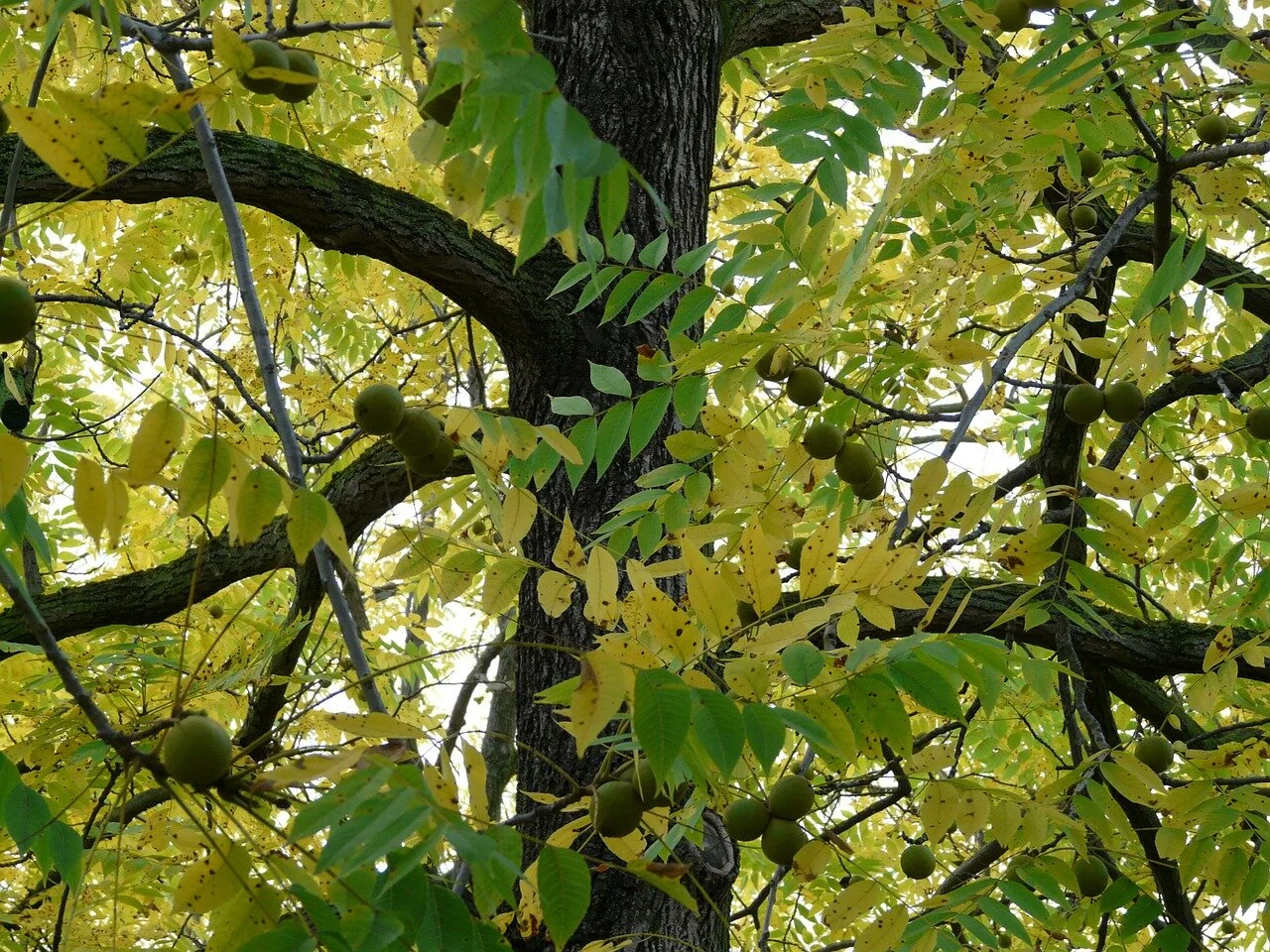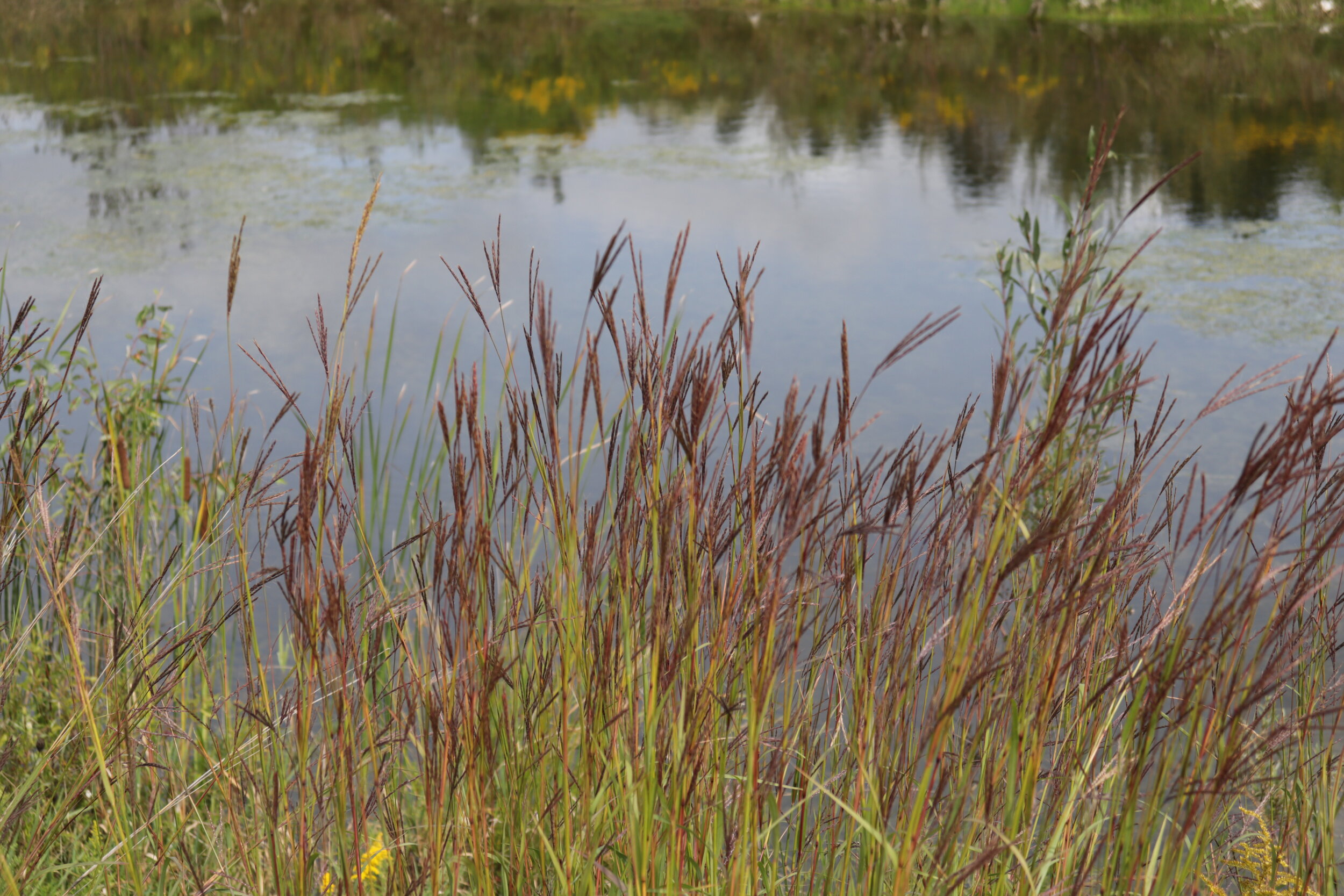Juglone (Walnut) Tolerant Native Plants
~For Ontario Gardens ~
~ By: Shaun Booth | Updated Dec 01 2020 ~
Black Walnuts (Juglans nigra) are majestic native trees with open, arching crowns and attractive foliage. They are great for supporting wildlife, as they host a variety of caterpillar species and their nuts provide an important source of protein and fats for wildlife of all kinds. Despite this, many gardeners have trouble growing a garden under Black Walnuts.
What is the “Problem” With Black Walnuts?
All parts of the Black Walnut contain juglone, including the roots, leaves and nuts.
Most members of the Walnut family (Juglandaceae) produce a chemical called Juglone which can cause toxic reactions with a number of other plant species that grow in their vicinity. This is also known as allelopathy and it can extend up to 20 meters from the trunk of the tree.
Juglone deprives sensitive plants of their ability to produce energy. It is produced by Hickories, Pecans, Butternut and other closely related species however, Black Walnut is the largest producer of juglone.
All parts of the Black Walnut contain juglone, including the roots, leaves and nuts.
These trees are often seen as a problem in gardens however, many of Ontario’s native plants have evolved to tolerate juglone and will grow quite well near them.
By choosing the right plants for the right spot, we can start to see Black Walnuts not as problem trees, but rather as opportunities to create unique backyard ecosystems that flourishes in harmony with these majestic trees.
The juglone tolerant plants in this list are based off personal experience and research from reputable sources. Most of them should be commercially available at your local native plant nursery.
Table of Contents:
There are a lot of plants to list here. They are organized into the following four categories:
Trees
Shrubs
Forbs (Wildflowers)
Grasses & Ferns
Juglone Tolerant Trees
Maples (Acer sp.)
Suitable Maples include Sugar Maple (acer saccharum), Red Maple (Acer rubrum) and Manitoba Maple (Acer negundo).
White Ash (Fraxinus americana)
Pawpaw (Asimina triloba)
An excellent understory tree, especially for those looking to include native edible plants in their landscapes. Thrives in shade and moist soils. It will also grow in the sun with increased fruit production.
Redbud (Cercis canadensis)
Redbud ( Cercis canadensis )
Redbud is an understory shrub that thrives in shade or sun alike.
Flowering Dogwood ( Cornus florida)
American Beech (Fagus grandifolia)
Honey locust (Gleditsia triacanthos)
Eastern red cedar (Juniperus virginiana)
Cherries (Prunus sp.)
Suitable species include Black Cherry (prunus serotina), Pin Cherry(Prunus pensylvanica), Chokecherry (Prunus virginiana). Chokecherry will be your best bet for plantingin the understory of a Walnut.
Oaks (Quercus sp.)
Willows (Salix sp.)
Sassafras (Sassafras albidum)
Eastern white cedar (Thuja occidentalis)
Juglone Tolerant Shrubs
Serviceberries (Amelanchier sp.)
Serviceberry (Amelanchier sp.)
Serviceberries generally do well near walnuts and are adaptable to a variety of growing conditions. Suitable species include Canada Serviceberry (Amelanchier canadensis), Low Serviceberry (Amelanchier alnifolia), Smooth Serviceberry (Amelanchier laevis), Shadbush (Amelanchier sanguinea) or Downy Serviceberry (Amelanchier arborea). Serviceberries have edible fruit so this is a good choice for an edible native plant garden near Walnut trees.
New Jersey Tea (Ceanothus americanus)
A low growing shrub with a deep taproot and preference for sunny, dry areas. The leaves can be used for tea so this can be a good native plant option for permaculture gardens near Walnut trees.
Alternate Leaf Dogwood (Cornus alternifolia)
Alternate Leaf Dogwood is an understory shrub/small tree that will thrive in the dappled shade of Walnut trees. It will also do well in full sun if the ground isn’t too dry.
Bunchberry (Cornus canadensis)
Red Osier Dogwood(Cornus sericea)
Hazelnuts (Corylus sp.)
Hazelnuts are useful edible native plants. Grow them under Walnut trees for a double nut harvest! Suitable species include American Hazelnut (Corylus americana) and Beaked Hazelnut ( Corylus cornuta). They will grow in shade but will produce more nuts in sunny conditions.
Hawthorns (Crataegus sp.)
Hawthorns are a diverse group with adaptations to a variety of growing conditions. Suitable species include Downy hawthorn (Crataegus mollis), Dotted hawthorn (Crataegus punctata), Cockspur hawthorn (Crataegus crus-galli), and Fleshy hawthorn (Crataegus succulenta). Hawthorns have edible fruits and can be used as in edible native plant gardens.
Leatherwood (Dirca palustrus)
Witch Hazel (Hamamelis virginiana)
A fall-blooming shrub that prefers moist soils in full sun to part shade.
Spicebush (Lindera benzoin) is a fragrant understory tree for under Walnuts.
Spicebush (Lindera benzoin)
SPicebush is an understory shrub with fragrant stems and leaves. It grows best in dappled shade and moist soil, so it’s perfect for under a Walnut tree. It will flower more in full sun, but only if the soil isn’t dry.
Ninebark (Physocarpus opulifolius)
Ninebark is a tough, adaptable shrub. It really needs full sun to thrive so it’s best suited to be near, but not under the shade of, Walnut trees.
Sumacs (Rhus sp.)
The Sumacs you want in your garden include Staghorn Sumac (Rhus typhina) and Fragrant Sumac (Rhus aromatica). Staghorn Sumac is a prolific spreader so it’s best suited for naturalization. Fragrant Sumac is better suited to a garden setting. Both need full sun to thrive so they are best not planted directly in the shade of a Walnut.
Roses (Rosa sp.) Blanda, carolina
Suitable species include Smooth Rose (Rosa blanda), Swamp Rose (Rosa palustris) and Carolina Rose (Rosa carolina). Smooth Rose favors dry areas like meadows while Carolina Rose and Swamp Rose will thrive in wetter soils. Smooth Rose has the least amount of thorns of Ontarios native roses.
Black Raspberry (Rubus occidentalis)
A delicious and adaptable native fruit. Grow in sun or shade, moist or dry soils.
Elderberries (Sambucus sp.)
Elderberries are multi-stemmed shrubs with showy flowers. Suitable species include Canada Elderberry (Sambucus canadensis) and Red Elderberry (Sambucus racemosa). Canada Elderberry thrives in full sun and moist soils where as Red Elderberry may be a more suitable option for directly under a Walnut as it thrives in shade.
Bladdernut (Staphylea trifolia)
A fast-growing small tree that thrives in shade. Generally used as an understory tree so it does well under big trees.
Viburnums (Viburnum sp.)
Attractive shrubs suited to a variety of growing conditions. Suitable species for Ontario include Smooth Arrowwood (Viburnum dentatum), Hobblebush (Viburnum lantanoides), Nannyberry ( Viburnum lentago), Highbush Cranberry (Viburnum trilobum).
Juglone Tolerant Vines
It is not recommended to grow vines up small trees as they can be too aggressive. Grow them up arbors or along fences instead.
Bittersweet Vine (Celastrus scandens)
Virgins Bower (Clematis virginiana)
Honeysuckle Vine (Lonicera dioica)
Virginia Creeper (Parthenocissus inserta)
Wild Grape (Vitis riparius)
Juglone Tolerant Forbs (wildflowers)
White Snakeroot (Ageratina altissima)
White Snakeroot spreads quickly by seeds and is best suited to a forest or open woods setting. It will tolerate full sun if the soil is moist.
Alliums (Allium tricoccum)
Alliums don’t seem to be affected by juglone. Suitable native species of Allium include Wild Leek(Allium tricoccum) and Nodding Onion (Allium cernuum). WIld Leek is an edible spring ephemeral that can be used like commercial leeks. Grows best in deciduous shade. Nodding Onion can be used in much the same way. It prefers full sun but will tolerate the dappled shade of a Walnut tree.
Anemones (Anemone sp.)
Anemones are a small group of native plants, with options for a variety of growing conditions. Try Canada Anemone (Anemone canadensis), Long-fruited Anemone (Anemone cylindrica), Thimbleweed (Anemone virginiana) or Cutleaf Anemone (Anemone multifida). Canada Anemone and Virginia Anemone are especially good for growing under Walnut trees.
Jack-in-the-pulpit (Arisaema triphyllum)
Jack-in-the-pulpit thrives in moist shady areas such as forest and swamps. It’s easy to grow and will do well under big trees.
Asters & Goldenrods are generally juglone tolerant.
Asters are a large and diverse group of plants, most of which are juglone tolerant. There is an aster for almost any growing condition from sun to shade, wet to dry. There are too many asters to list here but some of the most garden-worthy (and commercially available) asters are as follows: Calico Aster (Symphyotrichum lateriflorum), Flat-topped White Aster (Doellingeria umbellata), Heart-leaved Aster (Symphyotrichum cordifolium), Heath Aster (Symphyotrichum ericoides), Large-leaved Aster (Eurybia macrophylla), New England Aster (Symphyotrichum novae-angliae), Panicled Aster (Symphyotrichum lanceolatum), Purple-stemmed Aster (Symphyotrichum puniceum), Smooth Aster (Symphyotrichum laeve), White Wood Aster (Eurybia divaricata).
Marsh Marigold (Caltha palustris)
An early spring-blooming wildflower for moist areas and pond gardens. Grow this anywhere near Walnuts that stays constantly moist such as river banks, springs, ponds and low areas that don’t dry out. Stunning when planted on mass!
Harebell (Campanula rotundifolia)
The delicate blue flowers of Harebell are not phased by juglone and will bloom for months! Harebell needs dry soils and lots of sun so it’s not suited for under a large Walnut.
Trout Lily (Erythronium americanum)
Trout Lily is hard to find commercially but I wanted to add it here anyways because it’s juglone tolerant and one of the first spring wildflowers to emerge. It thrives in deciduous shade and goes dormant by mid-summer.
Boneset (Eupatorium perfoliatum)
Boneset is best suited to moist, sunny areas. If you have a walnut growing near a river or wet area then you need Boneset in your yard! Perfect for naturalization and gardens alike.
Spotted Geranium (Geranium maculatum) with a large Walnut in the background.
Spotted Joe-pye (Eutrochium maculatum)
Spotted Joe-pye is a wetland plant that thrives in full sun to part sun. It will be easy to grow well near Walnuts granted the soil is moist and it gets lots of sun.
Spotted Geranium (Geranium maculatum)
Spotted Geranium is naturally found in moist, well drained woodlands so it thrives in deciduous shade. It will also tolerate dry shade if there is enough organic matter in the soil. It is easy to grow in the shade of large Walnut trees.
Ontario gardeners have a wide range of native sunflowers to choose from. The following are native and juglone tolerant: Sunchoke (Helianthus tuberosus), Oxeye (Heliopsis helianthoides) Pale-leaved Sunflower (Helianthus strumosus), Tall Sunflower (Helianthus giganteus) and Woodland Sunflower (Helianthus divaricatus).
Sunflowers are best grown in full sun but Woodland Sunflower and Pale-leaved Sunflower will tolerate the dappled shade beneath Walnut trees.
Waterleafs (Hydrophyllum sp.)
Broad-leaved Waterleaf (Hydrophyllum canadense) and Virginia Waterleaf (Hydrophyllum virginianum) are both shade-tolerant understory plants. They are naturally found growing in moist, deciduous forests.
Blue Flag Iris (Iris versicolor)
Best grown in sunny, moist areas but will tolerate average soil moisture. Useful for ponds/streams with nearby Walnut trees.
Round-headed Bush Clover (Lespedeza capitata)
A nitrogen fixing plant that will tolerate sunny dry conditions.
Lilies (Lilium sp.)
Michigan Lily tolerates juglone.
Suitable species include Michigan Lily (Lilium michiganense) Wood Lily (Lilium philadelphicum).
Lobelias (Lobelia sp.) cardinalis, inflata, siphilitica
Lobelias are generally showy plants with long, tubular flowers. Suitable lobelias for near Walnuts include: Cardinal Flower (Lobelia cardinalis), Blue Lobelia (Lobelia siphilitica) and Indian Tobacco (Lobelia inflata)
Cardinal Flower and Blue Lobelia are suitable for moist areas such floodplains, ponds or wet meadows. They do best in full sun but can tolerate part shade. Blue Lobelia can tolerate slightly drier conditions than Cardinal Flower. Indian Tobacco is the outlier here as it is usually found in moist to dry woods so, out of the three Lobelias, it is the best choice for the shade of a walnut tree.
Virginia Bluebells (Mertensia virginica)
Like Black Walnuts, Virginia Bluebells are especially adapted to moist forests and floodplains so they grow very well together. Virginia Bluebells are spring ephemerals and go dormant by mid-summer, so be sure to plant them with another native plant that can fill the gaps. A good juglone tolerant choice would be Pennsylvania sedge.
Monardas (Monarda sp.)
Monardas are showy plants in the mint family (hence their fragrant foliage). We have a few great Monarda species to choose from in Ontario including Wild Bergamot (Monarda fistulosa), Dotted Mint (Monarda punctata) and Bee Balm (Monarda didyma). All three of these species do best in full sun, however, Wild Bergamot and Bee Balm can tolerate part shade. Note that Wild Bergamot is more susceptible to powdery mildew if it’s in too much shade so it might not be a good choice for directly under a Walnut tree.
Evening Primrose grows in sunny areas near Walnuts
Primroses (Oenothera sp.)
Suitable species include Evening Primrose (Oenothera biennis) and Sundrops (Oenothera fruticosa). Both will tolerate light shade but prefer full sun.
Obedient Plant (Physostegia virginiana)
Thrives in full sun and moist conditions.
Mayapple (Podophyllum peltatum)
An excellent shade tolerant native groundcover for beneath Walnut trees. Spreads quickly in moist soils.
Solomons Seals (Polygonatum sp.)
Solomons Seals are forest and woodland species so they can thrive as understory plants. Suitable species include Great Solomons Seal (Polygonatum commutatum), False Solomon's Seal (Maianthemum racemosum), Star-flowered Solomon's Seal (Maianthemum stellatum) and Hairy Solomon's Seal (Polygonatum pubescens).
Rudbeckia (Rudbeckia sp.)
Use Cutleaf Coneflower (Rudbeckia lanciniata) in moist areas with full to part sun. Black-eyed Susan (Rudbeckia hirta) is suitable for dry areas in full to part sun.
Bloodroot (Sanguinaria canadensis)
Bloodroot is a shade tolerant groundcover. It prefers moist, well-drained soils and full shade.
Goldenrods are a very diverse group of plants, most of which are juglone tolerant. There is a Goldenrod for almost any growing condition from sun to shade, wet to dry. There are too many Goldenrods to list here but some of the most garden-worthy (and commercially available) Goldenrods are as follows: Silverrod (Solidago bicolor), Blue-stemmed Goldenrod (Solidago caesia), Zigzag Goldenrod (Solidago flexicaulis), Grass-leaved Goldenrod (Solidago graminifolia), Bog Goldenrod (Solidago humilis), Stiff Goldenrod(Solidago rigida), Gray Goldenrod (Solidago nemoralis), Showy Goldenrod (Solidago speciosa).
Meadow Rues (Thalictrum sp.)
Early Meadow Rue (Thalictrum dioicum) and Tall Meadow Rue(Thalictrum dasycarpum). Early Meadow Rue is more suited to mesic to dry forests while Tall Meadow Rue is usually found in sunny moist areas.
Trilliums (Trillium sp.)
There are five native Trilliums in Ontario, but the two most commercially available are White Trillium (Trillium grandiflorum) and Red Trillium (Trillium erectum). Grow both of them in moist, well-drained soil in dappled shade.
Large-flowered Bellwort (Uvularia grandiflora)
Large-flowered Bellwort (Uvularia grandiflora)
Large-flowered Bellwort is a unique spring wildflower commonly found in moist and rocky woods. Despite this, it will also grow in the dry shade under large trees.
Ironweeds (Vernonia sp.)
Suitable species for Ontario native plant garden include Tall Ironweed (Vernonia altissima), New York Ironweed (Veronia noveboracensis). Both are suited to sunny, moist areas such as stream banks or moist meadows but will grow in average moisture.
Violets (Viola sp.)
Violas are a diverse group of plants. However, the most commercially available include Downy Yellow Violet (Viola pubescens), Canada Violet (Viola canadensis) and Common Violet (Viola sororia). Downy Yellow Violet and Canada Violet both thrive in forests and woodlands. Common Violet will grow just about anywhere you put it besides wet areas.
Juglone Tolerant Grasses/ferns
Big Bluestem (Andropogon gerardii)
Big Bluestem (Andropogon gerardii)
An iconic grass of Ontarios tallgrass prairie. Big Bluestem needs full sun to thrive.
Side-oats Grama (Bouteloua curtipendula)
A stunning short grass for dry, sunny sites. It will grow near Walnuts granted it has enough sun.
Rye’s (Elymus sp.)
The Elymus’s are the most shade tolerant grasses we have. Bottlebrush Grass (Elymus Hystrix) is best suited to shady sites. Virginia Rye (Elymus virginicus) and Canada Rye (Elymus canadensis) are adaptable and will grow in shade but do better in full sun.
Switch Grass (Panicum virgatum)
Switchgrass will grow in sun or part shade so it can go under or near a Walnut as they don’t produce deep shade.
Little Bluestem (Schizachyrium scoparium)
A short native grass that does best in full sun. It may tolerate light shade under a large tree but with less vigour.
Indian Grass (Sorghastrum nutans)
Another iconic grass of Ontario’s tallgrass prairies. Grows best in full sun.
Little Bluestem (Schizachyrium scoparium)
Prairie Dropseed (Sporobolus heterolepis)
A beautiful, mounding grass that thrives in dry, sunny sites.
Ostrich Fern (Matteuccia penslyvanica)
A fast spreading fern for moist, shady areas. This fern will quickly cover the ground under a Walnut if the soil is moist. In drier areas it may go dormant by late summer.
Sensitive Fern (Onoclea sensibilis)
Commonly found in moist woods and thickets. Sensitive fern will grow well under a walnut if the ground is moist. It will tolerate full sun in wet areas.
Christmas Fern (Polystichum acrostichoides)
A good choice for dry shade. Christmas fern will thrive under large Walnut trees and stays green all year long.
Summary:
As you can see, Ontario has a wide variety of native plants that will grow under or near Black Walnuts or other juglone producing trees. Typically, if one type of plant grows well under a Walnut then other plants within that family/genus will grow there too. I also encourage you to seek natural areas with Walnut trees and observe what grows under them naturally.













